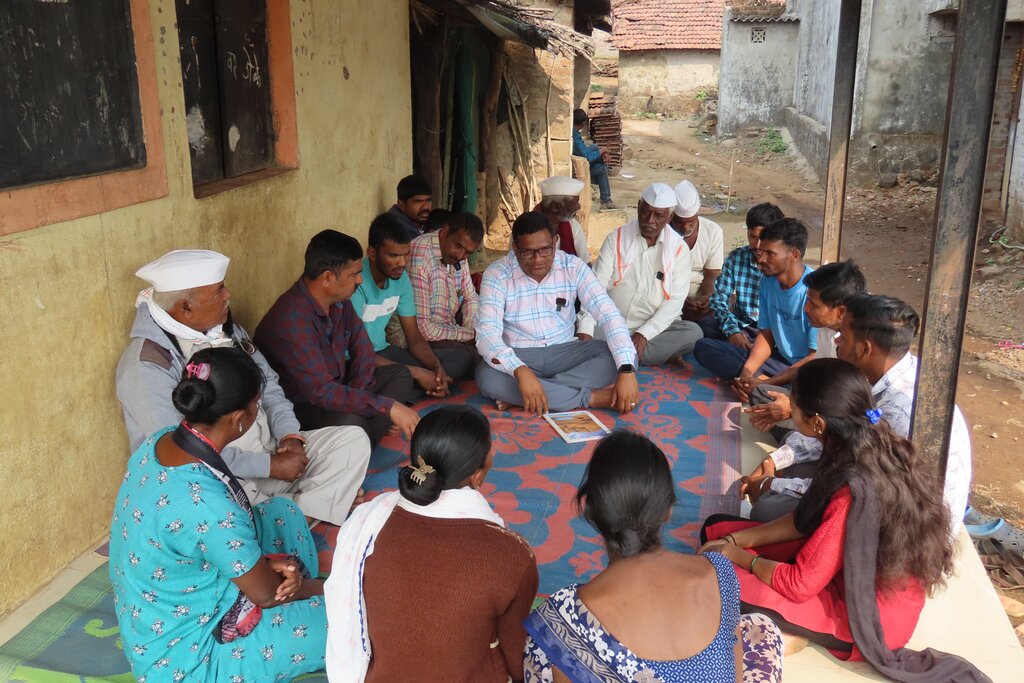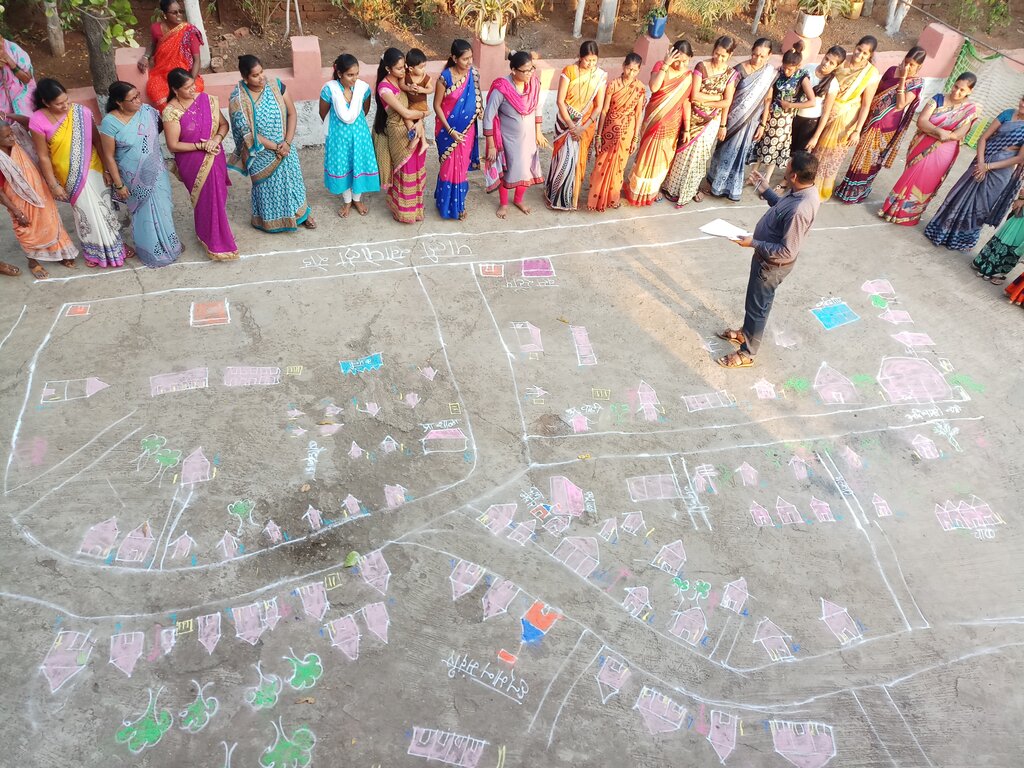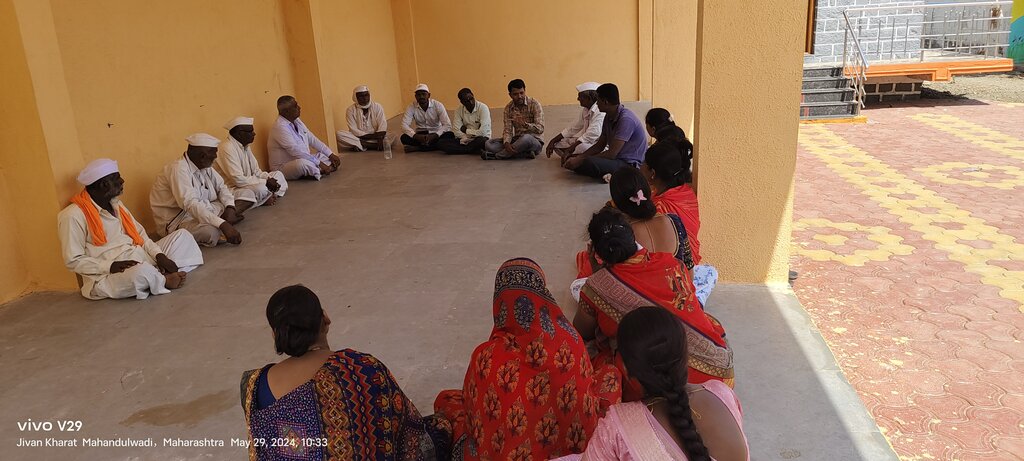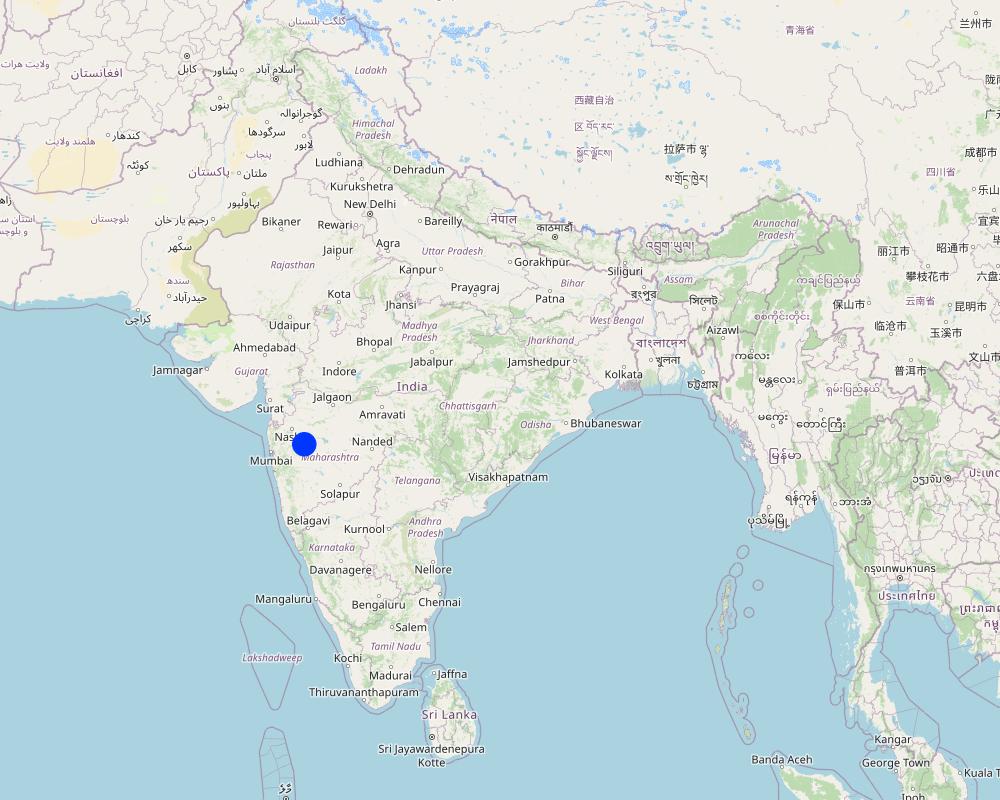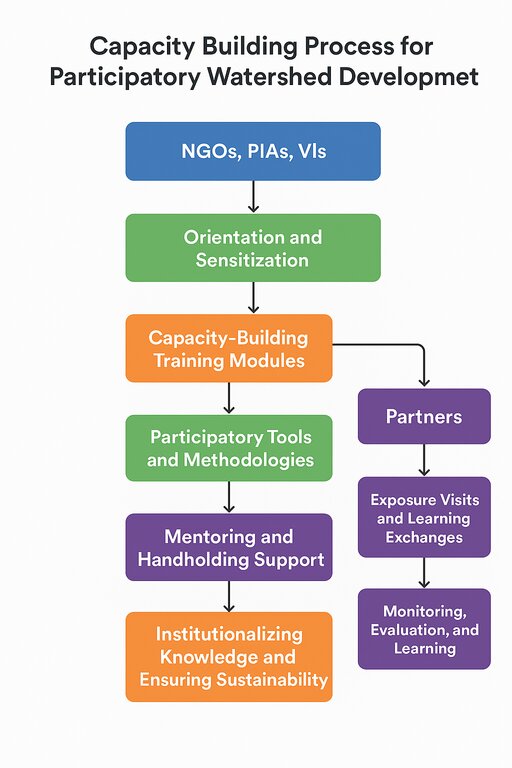Capacity Building Process for Participatory Watershed Development [ប្រទេសឥណ្ឌា]
- ការបង្កើត៖
- បច្ចុប្បន្នភាព
- អ្នកចងក្រង៖ Arun Bhagat
- អ្នកកែសម្រួល៖ –
- អ្នកត្រួតពិនិត្យ Udo Höggel
Community Participation in Participatory Watershed Development
approaches_7656 - ប្រទេសឥណ្ឌា
ពិនិត្យមើលគ្រប់ផ្នែក
ពង្រីកមើលទាំងអស់ បង្រួមទាំងអស់1. ព័ត៌មានទូទៅ
1.2 ព័ត៌មានលម្អិតពីបុគ្គលសំខាន់ៗ និងស្ថាប័នដែលចូលរួមក្នុងការវាយតម្លៃ និងចងក្រងឯកសារនៃវិធីសាស្ត្រផ្សព្វផ្សាយ
បុគ្គលសំខាន់ម្នាក់ (ច្រើននាក់)
អ្នកជំនាញឯកទេស SLM:
Rajapure Ganesh
+91 9422226412
ganesh.rajapure@wotr.org.in
Watershed Organisation Trust (WOTR)
Paryavaran Sarasnagar Road, Behind, Market Yard Road, Ahilyanagar, Maharashtra 414001
ប្រទេសឥណ្ឌា
អ្នកជំនាញឯកទេស SLM:
D’Souza Marcella
+91 9422226415
marcella.dsouza@gmail.com
W-CReS (the WOTR Centre for Resilience Studies), Watershed Organisation Trust (WOTR), Pune
The Forum, 2nd Floor, Pune - Satara Rd, above Ranka Jewellers, Padmavati Nagar, Corner, Maharashtra 411009
ប្រទេសឥណ្ឌា
អ្នកជំនាញឯកទេស SLM:
អ្នកជំនាញឯកទេស SLM:
Dadas Dada
+91 9892763960
dada.dadas@wotr.org.in
W-CReS (the WOTR Centre for Resilience Studies), Watershed Organisation Trust (WOTR), Pune
The Forum, 2nd Floor, Pune - Satara Rd, above Ranka Jewellers, Padmavati Nagar, Corner, Maharashtra 411009
ប្រទេសឥណ្ឌា
អ្នកជំនាញឯកទេស SLM:
Khedkar Vishnu
+91 7798818283
vishnu.khedkar@wotr.org.in
W-CReS (the WOTR Centre for Resilience Studies), Watershed Organisation Trust (WOTR), Pune
The Forum, 2nd Floor, Pune - Satara Rd, above Ranka Jewellers, Padmavati Nagar, Corner, Maharashtra 411009
ប្រទេសឥណ្ឌា
ឈ្មោះអង្គភាពមួយ (ច្រើន) ដែលបានចងក្រងឯកសារ/ វាយតម្លៃលើវិធីសាស្ត្រផ្សព្វផ្សាយ (បើទាក់ទង)
Watershed Organisation Trust (WOTR) - ប្រទេសឥណ្ឌា1.3 លក្ខខណ្ឌទាក់ទងទៅនឹងការប្រើប្រាស់ទិន្នន័យដែលបានចងក្រងតាមរយៈវ៉ូខេត
តើពេលណាដែលទិន្នន័យបានចងក្រង (នៅទីវាល)?
24/09/2025
អ្នកចងក្រង និង(បុគ្គលសំខាន់ៗ)យល់ព្រមទទួលយកនូវលក្ខខណ្ឌនានាទាក់ទងទៅនឹងការប្រើប្រាស់ទិន្នន័យដែលបានចងក្រងតាមរយៈ វ៉ូខេត:
បាទ/ចា៎
2. ការពណ៌នាអំពីវិធីសាស្ត្រផ្សព្វផ្សាយ SLM
2.1 ពណ៌នាសង្ខេបខ្លីពីវិធីសាស្ត្រផ្សព្វផ្សាយ
The Capacity Building Process for Participatory Watershed Development is a structured approach to strengthen the technical, managerial, and social skills of Non-Governmental Organizations (NGOs), Partner Implementation Agencies (PIAs), and Village-level Institutions (VIs). It includes orientation, training, participatory tools, mentoring, exposure visits, monitoring, and institutionalization. The process enhances competencies, fosters creativity and confidence, promotes community ownership, and ensures effective, sustainable planning, implementation, and management of watershed-based natural resource management and climate-resilient interventions.
2.2 ពណ៌នាលម្អិតពិវិធីសាស្ត្រផ្សព្វផ្សាយ
ពណ៌នាលម្អិតពិវិធីសាស្ត្រផ្សព្វផ្សាយ:
Capacity Building Process for Participatory Watershed Development:
Many Non-Governmental Organizations (NGOs), Partner Implementation Agencies (PIAs), and Village-level Institutions (VIs) aspire to implement participatory natural resource management (NRM) using a watershed approach. However, they often lack the technical expertise, practical skills, and experience needed for effective implementation. To address this gap, a structured capacity-building and induction strategy is essential. Such a strategy strengthen the technical and managerial competencies, nurtures creativity, and enhances their confidence to plan, implement, and sustain watershed interventions. In turn, it transforms their approach to resource mobilization, management, and sustainability. A common environmental challenge—such as water scarcity, land degradation, and climate change—creates opportunities to unite communities around shared needs. The Watershed Organisation Trust (WOTR) has effectively used watershed development as a unifying framework to bring people together, encouraging collective action for improving livelihoods and building resilience—especially among the poor and vulnerable.
Purpose of Capacity Building:
The overarching goal of the capacity-building process is to develop the knowledge, skills, attitudes, and confidence of NGOs, PIAs, and VIs in designing, implementing, and sustaining participatory, watershed-based NRM and climate-resilient development interventions.
Expected Outcomes:
•Improved competence in managing watershed-based NRM and climate change adaptation.
•Strengthened community ownership and participation.
•Effective and sustainable implementation of interventions.
•Positive transformation in approaches to resource mobilization and local governance.
Methodology and Key Steps:
The capacity-building approach comprises a series of interlinked steps, each reinforcing the others. Together, they form a comprehensive and adaptive learning process.
Step 1: Orientation and Sensitization
Objective: Build a common understanding and motivation among all project stakeholders.
Approach:
•Conduct orientation sessions explaining linkages between natural resources, livelihoods, and resilience.
•Share success stories and best practices to inspire commitment.
•Define roles and responsibilities of community-based organizations and NGOs.
Step 2: Capacity-Building Training Modules
Objective: Strengthen technical and managerial skills, especially among field-level stakeholders.
Core Modules:
•Technical Skills: Soil and water conservation, water budgeting, sustainable agriculture, climate resilience, and ecosystem-based adaptation.
•Social & Institutional Development: Social mobilization, gender inclusion, facilitation, group dynamics, and strengthening local institutions.
•Project Management: Planning, budgeting, reporting, and monitoring for effective implementation.
Step 3: Participatory Tools and Methodologies
Objective: Equip local groups with practical tools for participatory planning and action.
Tools and Methods:
•Participatory Rural Appraisal (PRA) tools such as resource mapping, seasonal calendars, and wealth ranking.
•Participatory Net Planning (PNP) for micro-level watershed planning.
•Use of digital tools and simple MIS platforms for data management and progress tracking.
Step 4: Mentoring and Handholding Support
Objective: Ensure continued learning, quality implementation, and motivation.
Approach:
•On-site technical and managerial guidance by experienced facilitators or resource NGOs.
•Regular review and feedback meetings to troubleshoot challenges.
•Peer learning and cross-visits among different project sites for shared learning.
Step 5: Exposure Visits and Learning Exchanges
Objective: Promote experiential and peer-to-peer learning.
Approach:
•Organize visits to successful watershed and NRM sites.
•Facilitate interactions with experienced community institutions and farmer groups.
•Encourage farmer-to-farmer extension to build local confidence and innovation.
Step 6: Monitoring, Evaluation, and Learning (MEL)
Objective: Foster accountability, reflection, and adaptive learning.
Approach:
•Train partners in participatory monitoring, data collection, documentation, and reporting.
•Develop and use simple, participatory monitoring tools to track outcomes and learning.
•WOTR’s existing participatory MEL tools are adapted for partners to ensure consistent data and insights.
Step 7: Institutionalizing Knowledge and Ensuring Sustainability
Objective: Build long-term local ownership and reduce dependence on external support.
Approach:
•Develop local resource persons, for example para-professionals.
•Establish local training and resource centers for continuous on-the-ground support.
•Document best practices, lessons learned, and local innovations for knowledge sharing.
•Gradually transfer leadership and responsibility to community institutions.
2.3 រូបភាពនៃវិធីសាស្ត្រផ្សព្វផ្សាយ
កំណត់សំគាល់ទូទៅរបស់រូបថត:
Photos of activities like resource mapping are important as they visually document community participation, local knowledge, and the planning process. They help capture the involvement of villagers, the use of PRA tools, and the mapping outcomes. Such photos serve as powerful evidence of participatory planning, support monitoring and reporting, and effectively communicate project processes and impacts to stakeholders and partners.
2.5 ប្រទេស/តំបន់/ទីតាំងកន្លែង ដែលវិធីសាស្ត្រផ្សព្វផ្សាយត្រូវបានអនុវត្តន៍
ប្រទេស:
ប្រទេសឥណ្ឌា
តំបន់/រដ្ឋ/ខេត្ត:
Maharashtra, MadhyaPradesh, Telangana, Karnataka, Jharkhand, Odisha, Chhattisgarh states
បញ្ជាក់បន្ថែមពីលក្ខណៈនៃទីតាំង:
Ahilyanagar, Jalna, Hyderabad, Sanga Reddy, Mandala, Gajapati, Rayagada, and more, etc.
មតិយោបល់:
Watershed Organisation Trust (WOTR), established in 1993, has been actively engaged in capacity building since its inception (Stared from this location). This participatory approach continues to be implemented in WOTR-supported villages across nine states in India.
Map
×2.6 កាលបរិច្ឆេទនៃការចាប់ផ្តើម និងបញ្ចប់នៃវិធីសាស្រ្តផ្សព្វផ្សាយនេះ
ប្រសិនអត់ចាំឆ្នាំ សូមចង្អុលបង្ហាញកាលបរិច្ឆេទប្រហែលៗពេលដែលវិធីសាស្ត្រផ្សព្វផ្សាយត្រូវបានចាប់ផ្តើមប្រើ:
10-50 ឆ្នាំ
មតិយោបល់:
Year of termination is not applicable because capacity building is essential in participatory watershed management.
2.7 ប្រភេទនៃវិធីសាស្ត្រផ្សព្វផ្សាយ
- The capacity-building process (approach) combines traditional and indigenous knowledge, recent local innovations, and project or program-based approaches for effective and sustainable watershed management.
2.8 គោលបំណង/ទិសដៅសំខាន់នៃវិធីសាស្ត្រផ្សព្វផ្សាយ
The main aims/objectives of the Capacity Building Process for Participatory Watershed Development are
• Strengthen technical, social, and managerial skills of NGOs, PIAs, and Village-level Institutions for effective watershed management.
• Promote participatory planning, community ownership, and active engagement in watershed interventions.
• Build project management capacity, including planning, budgeting, monitoring, and reporting.
• Support continuous learning through mentoring, exposure visits, and peer exchanges.
• Ensure sustainability by institutionalizing knowledge, developing local resource persons, and transferring leadership to communities.
2.9 លក្ខខណ្ឌអនុញ្ញាត ឬរារាំងការអនុវត្តន៍បច្ចេកទេសដែលស្ថិតនៅក្រោមវិធីសាស្រ្តផ្សព្វផ្សាយ
សង្គម/វប្បធម៌/ និងតម្លៃនៃសាសនា
- អំណោយផល
Living together for a common purpose forms the foundation of society. A strong sense of ownership and active participation is essential for achieving sustainable development.
ភាពអាចរកបាននៃធនធានហិរញ្ញវត្ថុ និងសេវាកម្ម
- អំណោយផល
Transparency acts as a social audit, it serves as an effective tool for accountability and openness.
បរិបទនៃស្ថាប័ន
- អំណោយផល
It provides a platform for community members to develop and exercise leadership.
ការសហការ/ការសម្របសម្រួលតួអង្គពាក់ព័ន្ធ
- អំណោយផល
It forms the foundation for building strong and sustainable institutions.
- រារាំង
Conflicts may arise among community members due to differing opinions, taboos, or perceptions.
ក្របខណ្ឌច្បាប់ (សិទ្ធិកាន់កាប់ដីធ្លី កម្មសិទ្ធីប្រើប្រាស់ដីនិងទឹក)
- អំណោយផល
Village-level Institutions (VIs) are linked with the local governing body, i.e., the Village Panchayat.
គោលនយោបាយ
- អំណោយផល
It facilitates the process of social auditing.
អភិបាលកិច្ចដី (ការសម្រេចចិត្ត ការអនុវត្ត និងការរឹតបន្តឹង)
- អំណោយផល
It enhances community participation in planning and implementation.
ចំណេះដឹងស្តីពី SLM និងការទទួលបានការគាំទ្រផ្នែកបច្ចេកទេស
- អំណោយផល
Through training that provides technical knowledge on the project’s key components.
ទីផ្សារ (ទិញធាតុចូល លក់ផលិតផល) និងតម្លៃ
- អំណោយផល
Training materials can be procured.
ទំហំការងារ ភាពអាចរកបាននៃកម្លាំងពលកម្ម
- អំណោយផល
Provides local animators to assist in project implementation.
3. ការចូលរួម និងតួនាទីរបស់ភាគីពាក់ព័ន្ធ
3.1 អ្នកពាក់ព័ន្ធដែលបានចូលរួមក្នុងវិធីសាស្ត្រផ្សព្វផ្សាយ និងតួនាទីរបស់ពួកគេ
- អ្នកប្រើប្រាស់ដីក្នុងតំបន់/សហគមន៍
Farmers, Women, and Youth
Consent to work, willingness to participate in mobilization activities, and attendance at capacity-building events.
- អង្គការសហគមន៍មូលដ្ឋាន
Men, Women, and Local Representatives
Making informed decisions and managing conflicts effectively. Encouraging active community participation, carefully selecting beneficiaries, and monitoring the impacts of interventions.
- អ្នកឯកទេសគ្រប់គ្រងដីប្រកបដោយចីរភាព/ទីប្រឹក្សាបច្ចេកទេសកសិកម្ម
NGO staff and team members
Planning, implementing, and monitoring activities
- អ្នកស្រាវជ្រាវ
Researchers and community members (men and women) involved in planning, implementation, and impact monitoring
Researchers design and guide training activities, facilitate knowledge sharing, provide technical expertise, monitor progress, and assess the impact of interventions to strengthen the skills and capacities of communities and stakeholders.
- គ្រូបង្រៀន/សិស្សក្មេងៗ/សិស្ស-និស្សិត
School and nursery teachers.
Facilitating learning, guiding children, and supporting community education initiatives
- អង្គការក្រៅរដ្ឋាភិបាល
Board members
Board resolution
- វិស័យឯកជន
Technical Expert - Individual or Group
Support to the SLM specialist
- រដ្ឋាភិបាលថ្នាក់មូលដ្ឋាន
Gram Panchayat (PRI)
Local governance body
Necessary resolutions
- រដ្ឋាភិបាលថ្នាក់ជាតិ (អ្នករៀបចំផែនការ អ្នកសម្រេចចិត្ត)
Concern Departments
Content and Guidelines for Capacity-Building Efforts
- អង្គការអន្តរជាតិ
Donor Agencies
Content and Guidelines for Capacity-Building Efforts
Funding, technical support, and guidance for community development and capacity-building initiatives
ប្រសិនមានភាគីពាក់ព័ន្ធច្រើនចូលរួមសូមចង្អុលបង្ហាញភ្នាក់ងារដែលនាំមុខគេ:
The main implementing agency will take the lead role in planning, coordinating, and executing the activities (Capacity-building processes are closely linked to project implementation, so the project’s nodal agency takes the lead role).
3.2 ការចូលរួមរបស់អ្នកប្រើប្រាស់ដីក្នុងតំបន់/ សហគមន៍ក្នុងតំបន់ក្នុងដំណាក់កាលផ្សេងគ្នានៃវិធីសាស្រ្តផ្សព្វផ្សាយ
| ការចូលរួមរបស់អ្នកប្រើប្រាស់ដីក្នុងតំបន់/សហគមន៍ក្នុងតំបន់ | សូមបញ្ជាក់នរណាត្រូវបានចូលរួម ព្រមទាំងពណ៌នាសកម្មភាពទាំងនោះ | |
|---|---|---|
| ការចាប់ផ្តើម/ការលើកទឹកចិត្ត | គំនិតផ្តួចផ្តើមដោយខ្ឡួនឯង | Community members need to demonstrate their willingness to actively participate in project planning and implementation. |
| ការរៀបចំផែនការ | អន្តរកម្ម | Farmers, CBO (Community-Based Organisation) members, women, and village-level animators actively participate in planning and review meetings, and contribute by passing resolutions in CBO meetings. |
| ការអនុវត្តន៍ | អន្តរកម្ម | Farmers, CBO members, women, and the project team actively participate in executing activities and in collecting relevant contributions. |
| ការត្រួតពិនិត្យ និងវាយតម្លៃ | អន្តរកម្ម | CBO members participate in joint monitoring visits and share information for impact documentation and research studies. |
| អន្តរកម្ម |
3.3 គំនូសបំព្រួញ (ប្រសិនបើមាន)
ការពណ៌នា:
This visual is illustrating a Capacity Building Process for Participatory Watershed Development using a step-by-step flowchart.
It starts with key implementing institutions such as NGOs, PIAs, and Village Institutions (VIs). The process begins with Orientation and Sensitization, followed by Capacity-Building Training Modules that strengthen skills and technical knowledge. From here, the approach branches into two parallel components:
1. Participatory Tools and Methodologies → enabling communities to actively take part in planning and decision-making.
2. Partners → supporting collaboration through exposure visits and knowledge sharing.
The next stage provides Mentoring and Handholding Support to guide field-level implementation.
Finally, the process moves to Institutionalizing Knowledge and Ensuring Sustainability, ensuring that skills, systems, and learnings remain within the community for long-term development impact. Overall, the diagram shows a structured learning pathway that builds capacity, supports practical application, and ensures sustainable watershed management.
អ្នកនិពន្ធ:
Dr. Arun Bhagat
3.4 ការសម្រេចចិត្តលើការជ្រើសរើសបច្ចេកទេស SLM
សូមបញ្ជាក់តើអ្នកណាជាអ្នកបានសម្រេចចិត្តក្នុងការជ្រើសរើសបច្ចេកទេសដើម្បីយកមកអនុវត្តន៍:
- គ្រប់ភាគីពាក់ព័ន្ធទាំងអស់ដែលជាផ្នែកនៃវិធីសាស្រ្តផ្សព្វផ្សាយដោយមានការចូលរួម
ចូរពន្យល់:
The NGO plays a leading role in initiating the process, while community members become actively involved as the process progresses.
សូមបញ្ជាក់ តើការសម្រេចធ្វើឡើងដោយផ្អែកលើអ្វីជាមូលដ្ឋាន:
- វាយតម្លៃទៅលើចំណេះដឹងស្តីអំពី SLM ដែលបានចងក្រងជាឯកសារបានត្រឹមត្រូវ (ផ្អែកលើភស្តុតាងជាមូលដ្ឋានដើម្បីសម្រេចចិត្ត)
4. ជំនួយបច្ចេកទេស ការកសាងសមត្ថភាព និងការគ្រប់គ្រងចំណេះដឹង
4.1 ការកសាងសមត្ថភាព/ បណ្តុះបណ្តាល
តើវគ្គបណ្តុះបណ្តាលបានផ្តល់ឱ្យអ្នកប្រើប្រាស់ដី/អ្នកពាក់ព័ន្ធផ្សេងៗទៀតដែរឬទេ?
បាទ/ចា៎
សូមបញ្ជាក់តើអ្នកណាត្រូវបានបណ្តុះបណ្តាល:
- អ្នកប្រើប្រាស់ដី
- បុគ្គលិកចុះទីវាល/អ្នកផ្តល់ប្រឹក្សាយោបល់
ប្រសិនទាក់ទង សូមបញ្ជាក់ ភេទ អាយុ ស្ថានភាពគ្រួសារ ជនជាតិដើមភាគតិច។ល។:
Community members of all age groups.
ទម្រង់នៃការបណ្តុះបណ្តាល:
- អនុវត្តន៍ជាមួយការងារ
- ពីកសិករទីកសិករ
- ទីតាំងបង្ហាញ
- ការប្រជុំជាសាធារណៈ
ប្រធានបទបណ្តុះបណ្តាល:
Key concepts and topics include: Environmental degradation, Natural Resource Management, Watershed Development, Participatory planning and monitoring tools, Community participation and contributions, Role of stakeholders, Portfolio management, Women empowerment, Gender inclusion, Sustainable agriculture, and Post-project management.
មតិយោបល់:
Training modules are designed to meet the specific needs of the project and location.
4.2 សេវាផ្តល់ប្រឹក្សាយោបល់
តើអ្នកប្រើប្រាស់ដីបានទទួលនូវសេវាផ្តល់ប្រឹក្សាដែរ ឬទេ?
បាទ/ចា៎
សូមបញ្ជាក់ប្រសិនបើសេវាកម្មប្រឹក្សាយោបល់ត្រូវបានផ្តល់ឱ្យ:
- នៅលើដីរបស់អ្នកប្រើប្រាស់ដី
ពណ៌នា/ពន្យល់:
In today’s era of climate change and volatile markets, Indian farmers face growing challenges that affect productivity and food security. Unlike urban areas that benefit from the digital revolution, rural farmers need timely, localized, and actionable information on sustainable farming practices. WOTR’s FarmPrecise app addresses this need, providing a comprehensive, data-driven tool to support informed agricultural decisions. Previously, WOTR developed an Agromet Advisory System delivering crop- and location-specific advisories via SMS using data from the India Meteorological Department (IMD). While valuable for weather forecasts, this system lacked personalization and direct farmer engagement.
WOTR launched the FarmPrecise app in 2019 to provide dynamic, farm-specific advisories. Since then, it has grown substantially, with over 1 lakh downloads, covering 30 crops across the Indian States of Maharashtra, Telangana, Odisha, and Madhya Pradesh, and is available in five languages: English, Hindi, Marathi, Telugu, and Odia.
4.3 ការពង្រឹងសមត្ថភាពស្ថាប័ន (ការអភិរឌ្ឍន៍អង្គភាព)
តើស្ថាប័នទាំងអស់ត្រូវបានបង្កើតឡើង ឬពង្រឹងសមត្ថភាពតាមរយៈវិធីសាស្ត្រផ្សព្វផ្សាយដែរ ឬទេ?
- បាទ/ច៎ា បានខ្លាំង
សូមបញ្ជាក់ថាតើស្ថាប័នត្រូវបានពង្រឹង ឬបង្កើតឡើងនៅត្រឹមកម្រិតណា(ច្រើន)?
- ថ្នាក់មូលដ្ឋាន
ចូពណ៌នាពីស្ថាប័ន តួនាទី និងទំនួលខុសត្រូវ សមាជិក ។ល។:
Village Development Committee (VDC): Responsible for planning and executing project activities, selecting beneficiaries and work sites, managing conflicts, overseeing community contributions, ensuring quality supervision and monitoring, maintaining records, and conducting social audits.
Self-Help Groups (SHGs): Organize women into savings and credit groups and manage SHG operations.
Village Water Management Team: Promote water budgeting, coordinate water governance, and support sustainable water management practices.
សូមបញ្ជាក់ប្រភេទនៃការគាំទ្រ:
- ការកសាងសមត្ថភាព/ បណ្តុះបណ្តាល
សូមផ្តល់ព័ត៌មានបន្ថែមទៀតឱ្យបានលម្អិត:
Capacity-building inputs are delivered in a sequence of trainings aligned with the project cycle tenure.
4.4 ការត្រួតពិនិត្យ និងវាយតម្លៃ
តើការត្រួតពិនិត្យ និងវាយតម្លៃគឺជាផ្នែកមួយនៃវិធីសាស្ត្រដែរឬទេ?
បាទ/ចា៎
មតិយោបល់:
In regular Community-Based Organization (CBO) trainings, the monitoring component is a key focus area.
ប្រសិន បាទ/ច៎ា តើឯកសារនេះបានបង្កើតឡើងក្នុងគោលបំណងប្រើប្រាស់សម្រាប់ការត្រួតពិនិត្យ និងវាយតម្លៃដែរឬទេ?
បាទ/ចា៎
មតិយោបល់:
It is used for follow-up purposes as well as for knowledge dissemination.
4.5 ការស្រាវជ្រាវ
តើការស្រាវជ្រាវ គឺជាផ្នែកមួយនៃវិធីសាស្រ្តដែរឬទេ?
បាទ/ចា៎
បញ្ជាក់ប្រធានបទ:
- សង្គមវិទ្យា
- សេដ្ឋកិច្ច/ទីផ្សារ
- បរិស្ថានវិទ្យា
- បច្ចេកវិទ្យា
សូមផ្តល់ព័ត៌មានបន្ថែមទៀតឱ្យបានលម្អិត និងចង្អុលបង្ហាញនរណាដែលបានធ្វើការស្រាវជ្រាវ:
The baseline survey tool is used for impact documentation. It helps reach beneficiaries to record their quality of life and assess the effects of project activities.
5. ថវិកា និងសម្ភារៈឧបត្ថម្ភពីខាងក្រៅ
5.1 ថវិកាប្រចាំឆ្នាំសម្រាប់ផ្សព្វផ្សាយ SLM
ប្រសិនបើចំនួនពិតប្រាកដនៃថវិកាប្រចាំឆ្នាំមិនត្រូវបានដឹងច្បាស់ សូមប្រាប់ពីចន្លោះនៃថវិកានោះ:
- < 2,000
មតិយោបល់ (ឧ. ប្រភពសំខាន់នៃមូលនិធិ/ម្ចាស់ជំនួយចំបង):
Main sources of funding / major donors: National and international donors, and Corporate Social Responsibility (CSR) contributions.
5.2 ការគាំទ្រផ្នែកហិរញ្ញវត្ថុ / សម្ភារៈដែលបានផ្តល់ទៅឱ្យអ្នកប្រើប្រាស់ដី
តើអ្នកប្រើប្រាស់ដីបានទទួលការគាំទ្រផ្នែកហិរញ្ញវត្ថ/សម្ភារៈសម្រាប់ការអនុវត្តន៍បច្ចេកទេសដែរឬទេ:
បាទ/ចា៎
ប្រសិនបាទ/ច៎ា សូមបញ្ជាក់ប្រភេទ(ច្រើន)នៃការគាំទ្រ លក្ខខណ្ឌ និងអ្នកផ្តល់ឱ្យ(ច្រើន):
Although not through direct financial or material support, land users (community) benefit from improved skills and knowledge, and gain advantages through active participation and involvement.
5.3 សូមបញ្ជាក់ពីធាតុចូលត្រូវបានផ្តល់បដិភាគ (រួមទាំងកម្លាំងពលកម្ម)
- គ្មាន
ប្រសិនបើកម្លាំងពលកម្មធ្វើដោយអ្នកប្រើប្រាស់ដី តើវាជាធាតុចូលដ៏សំខាន់មួយដែរ ឬទេ:
- ដោយស្ម័គ្រចិត្ត
មតិយោបល់:
While labor is not required, participation of land users in the capacity-building process is essential. Landowners contribute their knowledge and time to share ideas and insights.
5.4 ឥណទាន
តើឥណទានដែលបានផ្តល់នៅក្រោមវិធីសាស្ត្រផ្សព្វផ្សាយសម្រាប់សកម្មភាព SLM នេះយ៉ាងដូចម្តេច?
ទេ
5.5 ការលើកទឹកចិត្ត ឬវិធីសាស្ត្រដ៏ទៃទៀត
តើមានការលើកទឹកចិត្តផ្សេងទៀត ឬឧបករណ៍ប្រើប្រាស់ដើម្បីលើកកម្ពស់ការអនុវត្តន៍បច្ចេកទេស SLM?
ទេ
6. ការវិភាគរកផលប៉ះពាល់ និងសេចក្តីសន្និដ្ឋាន
6.1 ផលប៉ះពាល់នៃវិធីសាស្ត្រផ្សព្វផ្សាយ
តើវិធីសាស្ត្រផ្សព្វផ្សាយបានផ្តល់សិទ្ធិអំណាចដល់អ្នកប្រើប្រាស់ដី ធ្វើឱ្យប្រសើរឡើងនូវការចួលរួមអ្នកពាក់ព័ន្ធ?
- ទេ
- បាទ/ច៎ា បន្តិចបន្តួច
- បាទ/ច៎ា ជាមធ្យម
- បាទ/ច៎ា បានខ្លាំង
Greater awareness and better understanding of project management and its impact on project components led to higher participation
តើវិធីសាស្រ្តផ្សព្វផ្សាយនេះអនុញ្ញាតឱ្យធ្វើការសម្រេចចិត្ដដោយផ្អែកលើភស្តុតាងជាមូលដ្ឋានដែរ ឬទេ?
- ទេ
- បាទ/ច៎ា បន្តិចបន្តួច
- បាទ/ច៎ា ជាមធ្យម
- បាទ/ច៎ា បានខ្លាំង
The progress of project components is presented in common meetings, such as Gram Sabhas, enabling CBO members to make informed decisions.
តើវិធីសាស្ត្រផ្សព្វផ្សាយជួយអ្នកប្រើប្រាស់ដីដើម្បីអនុវត្តន៍ និងថែទាំបច្ចេកទេស SLM?
- ទេ
- បាទ/ច៎ា បន្តិចបន្តួច
- បាទ/ច៎ា ជាមធ្យម
- បាទ/ច៎ា បានខ្លាំង
Active and well-informed participation in planning, execution, and ensuring quality work.
តើវិធីសាស្រ្តផ្សព្វផ្សាយនេះធ្វើឱ្យប្រសើរឡើងនូវការសម្របសម្រួលនិងការអនុវត្តចំណាយរបស់ SLMមានប្រសិទ្ធិភាពបែបណា? :
- ទេ
- បាទ/ច៎ា បន្តិចបន្តួច
- បាទ/ច៎ា ជាមធ្យម
- បាទ/ច៎ា បានខ្លាំង
Capacity building produces synergistic outcomes.
តើវិធីសាស្រ្តផ្សព្វផ្សាយនេះប្រមូលផ្តុំ / ធ្វើឱ្យប្រសើរឡើងនូវការទទួលបានធនធានហិរញ្ញវត្ថុសម្រាប់ការអនុវត្ត SLM?
- ទេ
- បាទ/ច៎ា បន្តិចបន្តួច
- បាទ/ច៎ា ជាមធ្យម
- បាទ/ច៎ា បានខ្លាំង
The participatory Net Planning (PNP) tool in support of capacity building approach facilitates proper land-use planning with budget allocation for specific plots.
តើវិធីសាស្ត្រផ្សព្វផ្សាយនេះធ្វើឱ្យចំណេះដឹងប្រសើឡើង និងសមត្ថភាពរបស់អ្នកប្រើប្រាស់ដីក្នុងការអនុវត្តន៏ SLM?
- ទេ
- បាទ/ច៎ា បន្តិចបន្តួច
- បាទ/ច៎ា ជាមធ្យម
- បាទ/ច៎ា បានខ្លាំង
Capacity building activities and net planning exercises provide inputs on the technical know-how of watershed structures.
តើវីធីសាស្ត្រផ្សព្វផ្សាយនេះពង្រឹងចំណេះដឹង និងកសាងសមត្ថភាពរបស់អ្នកពាក់ព័ន្ធឬទេ?
- ទេ
- បាទ/ច៎ា បន្តិចបន្តួច
- បាទ/ច៎ា ជាមធ្យម
- បាទ/ច៎ា បានខ្លាំង
The capacity-building approach improved stakeholders’ knowledge and skills through training, hands-on exercises, participatory planning, and active involvement in decision-making.
តើវីធីសាស្ត្រនេះបានជួយកសាង/ពង្រឹងស្ថាប័ន កិច្ចសហប្រតិបត្តិការរវាងអ្នកពាក់ព័ន្ធដែរ ឬទេ?
- ទេ
- បាទ/ច៎ា បន្តិចបន្តួច
- បាទ/ច៎ា ជាមធ្យម
- បាទ/ច៎ា បានខ្លាំង
The capacity-building process brings all stakeholders onto a common platform, fostering a shared vision, sustainable impact, and resilience.
តើវីធីសាស្ត្រផ្សព្វផ្សាយនេះបានកាត់បន្ថយជំលោះឬទេ?
- ទេ
- បាទ/ច៎ា បន្តិចបន្តួច
- បាទ/ច៎ា ជាមធ្យម
- បាទ/ច៎ា បានខ្លាំង
It helps unite the community and reduces conflicts related to resource management.
តើវិធីសាស្ត្រផ្សព្វផ្សាយនេះផ្តល់សិទ្ធិអំណាចដល់សង្គមនិងសេដ្ឋកិច្ចដែលក្រុមមិនទទួលបានផលប្រយោជន៍?
- ទេ
- បាទ/ច៎ា បន្តិចបន្តួច
- បាទ/ច៎ា ជាមធ្យម
- បាទ/ច៎ា បានខ្លាំង
The principle of equity was upheld during the capacity-building process, with community members from all sectors actively involved and given equal representation in CBO and VI structures.
តើវិធីសាស្ត្រផ្សព្វផ្សាយ បានធ្វើឱ្យប្រសើរឡើងសមភាពយេនឌ័រ និងផ្តល់សិទិ្ធអំណាចដល់ស្ត្រី និងក្មេងស្រី?
- ទេ
- បាទ/ច៎ា បន្តិចបន្តួច
- បាទ/ច៎ា ជាមធ្យម
- បាទ/ច៎ា បានខ្លាំង
Special emphasis was placed on women, with a separate Plan of Participation (POP) developed to ensure their inclusion and promote gender equity.
តើវិធីសាស្ត្រផ្សព្វផ្សាយបានលើកទឹកចិត្តដល់អ្នកប្រើប្រាស់ដីដែលជាយុវជន/ក្មេងជំនាន់ក្រោយឱ្យចូលរួមក្នុង SLM ?
- ទេ
- បាទ/ច៎ា បន្តិចបន្តួច
- បាទ/ច៎ា ជាមធ្យម
- បាទ/ច៎ា បានខ្លាំង
Special focus was placed on engaging youth in the net planning process to ensure their active participation in local support and supervision.
តើវិធីសាស្ត្រផ្សព្វផ្សាយបានឱ្យប្រសើរឡើងនូវបញ្ហាកាន់កាប់ដីធ្លី/សិទ្ធិអ្នកប្រើប្រាស់ដែលរារាំងដល់ការអនុវត្ត SLM?
- ទេ
- បាទ/ច៎ា បន្តិចបន្តួច
- បាទ/ច៎ា ជាមធ្យម
- បាទ/ច៎ា បានខ្លាំង
Informal land user issues are resolved during the implementation process.
តើវិធីសាស្ត្រផ្សព្វផ្សាយនាំឱ្យប្រសើរឡើងនូវសន្តិសុខស្បៀង/ធ្វើឱ្យប្រសើរឡើងនូវអាហាររូបត្ថម្ភ?
- ទេ
- បាទ/ច៎ា បន្តិចបន្តួច
- បាទ/ច៎ា ជាមធ្យម
- បាទ/ច៎ា បានខ្លាំង
A well-designed capacity-building process ensures quality implementation, leading to better outcomes.
តើវិធីសាស្ត្រផ្សព្វផ្សាយធ្វើឱ្យប្រើសើរឡើងនូវការស្វែងរកទីផ្សារ?
- ទេ
- បាទ/ច៎ា បន្តិចបន្តួច
- បាទ/ច៎ា ជាមធ្យម
- បាទ/ច៎ា បានខ្លាំង
Market-related inputs are included in the training modules.
តើវិធីសាស្ត្រផ្សព្វផ្សាយនេះនាំឱ្យមានភាពប្រសើរឡើងក្នុងការទទួលបានទឹក និងអនាម័យ?
- ទេ
- បាទ/ច៎ា បន្តិចបន្តួច
- បាទ/ច៎ា ជាមធ្យម
- បាទ/ច៎ា បានខ្លាំង
A well-designed capacity-building process leads to quality implementation, resulting in positive outcomes.
តើវិធីសាស្ត្រផ្សព្វផ្សាយនេះនាំឱ្យមានកាប្រើប្រាស់ប្រកបដោយចីរភាព/ប្រភពនៃថាមពលកាន់តែប្រើសើរឡើង?
- ទេ
- បាទ/ច៎ា បន្តិចបន្តួច
- បាទ/ច៎ា ជាមធ្យម
- បាទ/ច៎ា បានខ្លាំង
The capacity-building approach promoted sustainable energy use by training stakeholders on efficient practices, demonstrating renewable technologies, and encouraging participatory planning for optimal resource use.
តើវិធីសាស្ត្របានធ្វើឱ្យប្រសើរឡើងនូវការកសាងសមត្ថភាពរបស់អ្នកប្រើប្រាស់ដីដើម្បីបន្សុំាទៅនឹងការប្រែប្រួលអាកាសធាតុ/អាកាសធាតុក្តៅហែង និងកាត់បន្ថាយគ្រោះមហន្តរាយទាក់ទឹងនឹងអាកាសធាតុ?
- ទេ
- បាទ/ច៎ា បន្តិចបន្តួច
- បាទ/ច៎ា ជាមធ្យម
- បាទ/ច៎ា បានខ្លាំង
A well-designed capacity-building process, combined with effective training, ensures quality implementation, leading to positive outcomes and impacts, while enhancing individuals’ resilience through adaptation.
តើវិធីសាស្ត្រផ្សព្វផ្សាយនេះនាំឱ្យមានការងារ ឱកាសរកប្រាក់ចំណូល?
- ទេ
- បាទ/ច៎ា បន្តិចបន្តួច
- បាទ/ច៎ា ជាមធ្យម
- បាទ/ច៎ា បានខ្លាំង
Improved agriculture creates both on-farm and off-farm livelihood opportunities.
6.2 ការលើកទឹកចិត្តចម្បងៗរបស់អ្នកប្រើប្រាស់ដីសម្រាប់ការអនុវត្តបច្ចេកទេស SLM
- បង្កើនផលិតកម្ម
Enhanced soil moisture and soil quality, along with increased awareness and adoption of improved agricultural practices.
- ការកាត់បន្ថយការធ្លាក់ចុះគុណភាពដី
Reduced soil erosion and land degradation, along with improved knowledge of water and land management practices.
- ច្បាប់ និងបទបញ្ជា (ផាកពិន័យ)/ការប្រតិបត្តិ
Land users practice and uphold equality at all levels.
- ពង្រឹងស្មារតីផ្នែកបរិស្ថាន
Integration of climate change–related topics into capacity-building strategies.
- លើកកម្ពស់ចំណេះដឹង និងជំនាញ SLM
A structured and systematic process for implementing Sustainable Land Management (SLM) practices.
6.3 សកម្មភាពផ្សព្វផ្សាយដែលប្រកបដោយចីរភាព
តើអ្នកប្រើប្រាស់ដីអាចធ្វើឱ្យមានចីរភាពនូវអ្វីដែលត្រូវបានអនុវត្តន៍តាមរយៈវិធីសាស្ត្រផ្សព្វផ្សាយដែរឬទេ(ដោយពុំមានការគាំទ្រពីអ្នកខាងក្រៅ)?
- បាទ/ចា៎
ប្រសិនបាទ/ច៎ា សូមរៀបរាប់ថាធ្វើយ៉ាងម៉េច:
The principle of ‘learning by doing’ is central to the capacity-building process. Communities gain hands-on experience in various project components, developing strong technical and managerial skills at the local level. This enhances sustainability, as trained village institutions such as VDC members and community workers possess the necessary knowledge and skills for continued implementation and impact documentation.
6.4 ភាពខ្លាំង/ គុណសម្បត្តិនៃវិធីសាស្ត្រផ្សព្វផ្សាយ
| ភាពខ្លាំង/ គុណសម្បត្តិ/ ឱកាស ទស្សនៈរបស់អ្នកប្រើប្រាស់ដី |
|---|
| Inclusion of Indigenous Knowledge: The approach allows local and traditional knowledge to be integrated into planning and implementation, making interventions more relevant and practical to the local context. |
| Enhanced Knowledge on NRM: Land users gain valuable knowledge and information about Natural Resource Management (NRM), helping them make informed decisions on soil, water, and land use practices. |
| Leadership Development: Community members get opportunities to take leadership roles in planning and decision-making processes, strengthening local governance and ownership. |
| Social Inclusion: The process ensures participation from all sections of society, including marginalized groups, women, and youth, promoting equity and collective action. |
| ភាពខ្លាំង/ គុណសម្បត្តិ/ ឱកាស ទស្សនៈរបស់បុគ្គលសំខាន់ៗ |
|---|
| Systematic Approach: The capacity-building process follows a structured and step-by-step framework, ensuring consistency, clarity, and efficiency in planning, implementation, and monitoring. |
| Tested and Proven Strategy: The approach is based on field-tested methodologies and past experiences, which have demonstrated successful outcomes in participatory watershed and NRM projects. |
| Operational Guidelines: Well-defined operational guidelines provide a clear roadmap for facilitators and implementing agencies, helping to standardize procedures and maintain quality across different project sites. |
| Set of Tools: The process includes a comprehensive toolkit—such as participatory planning tools, training modules, and monitoring formats—which helps streamline learning, participation, and evaluation. |
6.5 ភាពខ្សោយ/ គុណវិបត្តិនៃវិធីសាស្ត្រ និងរកដំណោះស្រាយ
| ភាពខ្សោយ/ គុណវិបត្តិ/ ហានិភ័យ ទស្សនៈរបស់អ្នកប្រើប្រាស់ដី | តើបច្ចេកទេសទាំងនោះបានដោះស្រាយបញ្ហាដូចម្តេច? |
|---|---|
| Time Constraints: The capacity-building process requires continuous engagement, which can be time-consuming and may interfere with regular livelihood activities of land users. |
Flexible Organization of Capacity-Building (CB) Events: Conduct training and awareness sessions at times and locations convenient for community members to ensure higher participation, especially for women and farmers with field responsibilities. Use of Social Media and Digital Platforms: Share project updates, training materials, and success stories through WhatsApp groups, community radio, and other social media tools to reach a wider audience effectively. |
| Lack of Confidence to Participate: Some community members, especially those with limited education or exposure, may initially hesitate to engage actively in discussions or decision-making. |
Rapport Building: Establishing trust and positive relationships with community members helps facilitators engage participants more effectively and encourages open communication. Interactive Methods – Games, Exercises, Personal Talks, and Corner Meetings: Use participatory and informal methods to make learning enjoyable, build confidence, and promote active involvement among community members. Use of Participatory Rural Appraisal (PRA) Tools: PRA methods like mapping, ranking, and seasonal calendars help participants express local knowledge and experiences, increasing confidence and ownership in the planning process. |
| Social Constraints and Gender Barriers: Cultural taboos and social norms may restrict women’s participation in meetings or leadership roles, limiting their ability to contribute fully to capacity-building and project implementation. |
Encouraging attendance and use of Information: Motivate community members to regularly attend meetings, apply shared knowledge in their practices, and contribute ideas for better project outcomes. Confidence Building Among Men and Women: Conduct targeted sessions to enhance the confidence of both men and women, ensuring balanced participation and reducing gender-based hesitation in community discussions. |
| ភាពខ្សោយ/ គុណវិបត្តិ/ ហានិភ័យក្នុងទស្សនៈរបស់បុគ្គលសំខាន់ៗ | តើបច្ចេកទេសទាំងនោះបានដោះស្រាយបញ្ហាដូចម្តេច? |
|---|---|
| Language and Cultural Barriers: Differences in language and cultural practices can make it difficult to communicate technical concepts effectively, especially in diverse and multi-lingual communities. | Rapport Building and Understanding of the Community: Spend adequate time in the field to understand local culture, traditions, and social dynamics. Building mutual trust enhances participation and improves the quality of capacity-building interventions. |
| Limited Literature in Local Language: The scarcity of training materials and technical documents in local languages restricts understanding and limits wider participation at the grassroots level. | Translation of Reading and Training Materials: Translate manuals, handouts, and key reference materials into local languages to make technical content accessible to all community members and ensure uniform understanding. |
| Communication and Facilitation Skills: Successful capacity building depends on skilled facilitators. In some cases, inadequate communication or facilitation skills among trainers can reduce the effectiveness of training sessions and field interactions. | Upgrading Skills of Trainers and Facilitators: Provide regular refresher training and exposure opportunities for facilitators to enhance their communication, facilitation, and technical skills—ensuring more effective delivery of capacity-building programs. |
7. ឯកសារយោង និងវេបសាយ
7.1 វិធីសាស្ត្រ/ ប្រភពនៃព័ត៌មាន
- តាមការចុះទីវាល ការស្រាវជ្រាវនៅទីវាល
Two field visits are conducted to engage the village community in discussions on the capacity-building process, its impact, importance, and role in fostering ownership.
- ការសម្ភាសន៍ជាមួយអ្នកប្រើប្រាស់ដី
Interviews were conducted with six land users.
- ការសម្ភាសន៍ជាមួយអ្នកជំនាញ/ ឯកទេស
Interviews were conducted with five land users.
- ការចងក្រងពីរបាកការណ៍ និងឯកសារផ្សេងៗទៀតដែលមាន
The information is sourced from a capacity-building methodology that has been developed and is currently under publication.
7.2 ឯកសារយោងដែលបានចេញផ្សាយ
ចំណងជើង អ្នកនិពន្ធ ឆ្នាំ ISBN:
WATERSHED DEVELOPMENT GUIDELINES (Revised 2001), Community and Rural Development Department,
មានប្រភពមកពីណា? ថ្លៃដើមប៉ុន្មាន?
https://megcnrd.gov.in/forms/WSD.pdf
ចំណងជើង អ្នកនិពន្ធ ឆ្នាំ ISBN:
The Wasundhara Approach. 2013. Watershed Organisation Trust (WOTR).
មានប្រភពមកពីណា? ថ្លៃដើមប៉ុន្មាន?
https://www.yumpu.com/en/document/read/19427351/the-wasundhara-approach-wotr
7.3 ចូលទៅទាញយកឯកសារពាក់ព័ន្ធដែលមានលើបណ្តាញអ៊ិនធឺណែត
ចំណងជើង/ ពណ៌នា:
Wasundhara Approach, Watershed Organisation Trust (WOTR)
វេបសាយ:
https://www.youtube.com/watch?v=r3YHpkm9qFY&t=364s
ចំណងជើង/ ពណ៌នា:
Water Gives Life, Watershed Organisation Trust (WOTR)
វេបសាយ:
https://www.youtube.com/watch?v=thdevpZ-vio&t=149s
ចំណងជើង/ ពណ៌នា:
How to do Wealth Ranking in Watershed
វេបសាយ:
https://www.youtube.com/watch?v=ygiAy7f7Gpc
ចំណងជើង/ ពណ៌នា:
Wasundhara
វេបសាយ:
https://www.youtube.com/watch?v=r3YHpkm9qFY&t=364s
ចំណងជើង/ ពណ៌នា:
A New Beginning
វេបសាយ:
https://www.youtube.com/watch?v=LBzF7DXbedM&t=2s
ចំណងជើង/ ពណ៌នា:
Rising Together: Building Resilient Communities for a Sustainable Tomorrow
វេបសាយ:
https://www.youtube.com/watch?v=0gCFkwkfwdg&t=2s
ការតភ្ជាប់ និងម៉ូឌុល
ពង្រីកមើលទាំងអស់ បង្រួមទាំងអស់ការតភ្ជាប់
គ្មានការតភ្ជាប់
ម៉ូឌុល
គ្មានម៉ូឌុល



